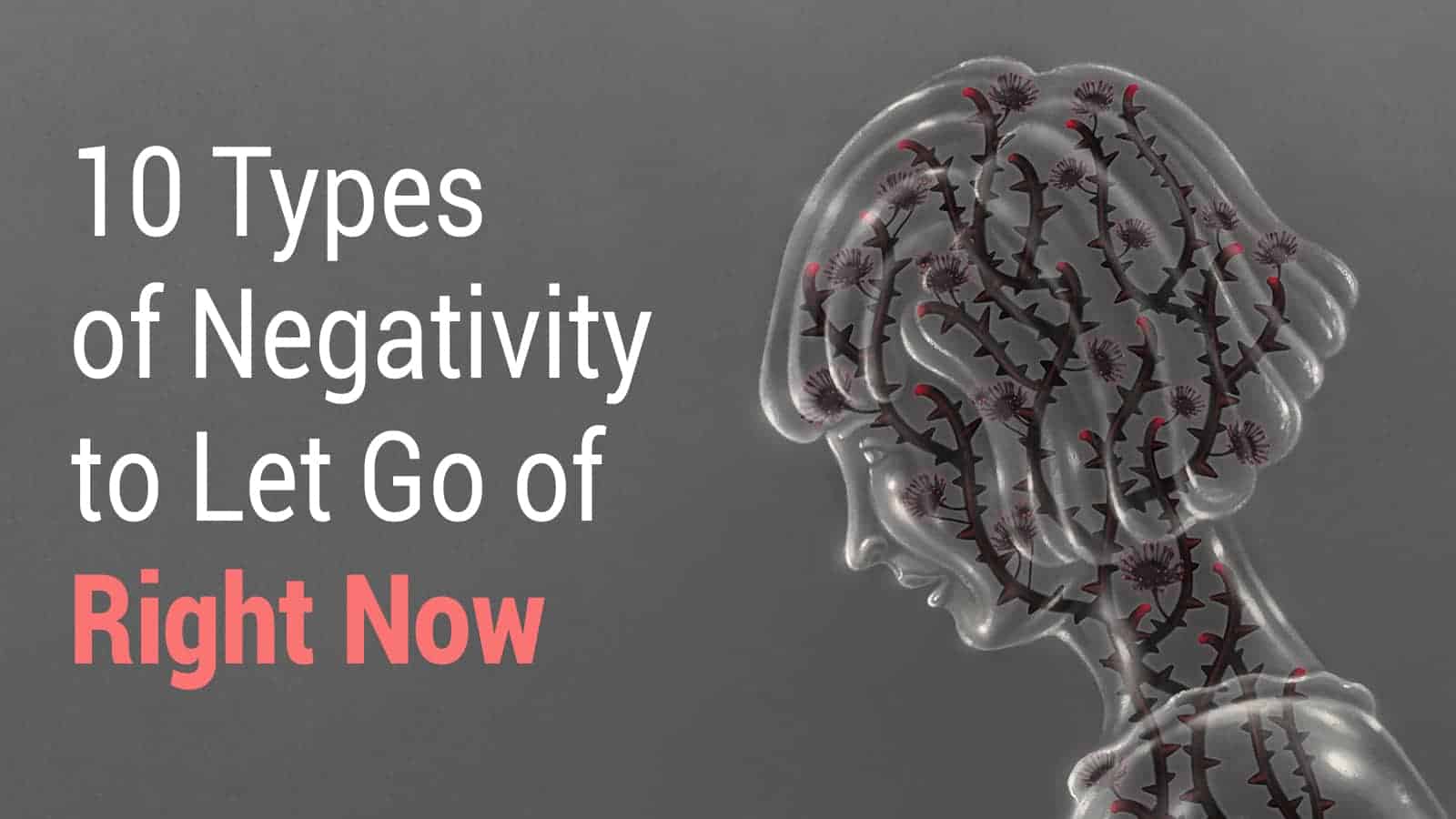Have you ever wondered exactly why you remember all the mean things people have said to you more than the beautiful things they’ve said to you? That’s because your brain is hard-wired to remember negative experiences in life. And this sets you up for a negative mindset to gain a stronghold in your thoughts and actions. It can affect your friendships, your work, and your decisions. If you struggle with being overly negative, it’s crucial to find ways to let it go, especially of the more destructive types of negativity.
Here are the ten types of negativity you need to get rid of right now
Release the burden of these negative thoughts–you’ll be all the happier for it in the long run!
1 – Blameshifting
Blameshifting is blaming others or situations for your own failure. Studies say blameshifting is a tool people use to push away criticism. But the same study found that blameshifting usually backfires because people don’t like blame shifters. Think here of politicians who make sweeping campaign promises, then blame others when the commitments aren’t met, even though it’s their fault. Blaming your spouse, kids, or your upbringing is a form of negativity that weighs you down and distorts your view of life.
How to let go:
The next time you’re tempted to blame someone or something, stop and decide not to blameshift. Allow yourself to accept the situation and admit your own fault when needed. Find peace in letting go of this negative attitude.
2 – Being a perfectionist
If you are a perfectionist, then you want to do things in an utterly perfect way. You set high standards for yourself and others. No one is perfect, and to set your goals on perfectionism is unrealistic. It’s a negative view of yourself because you’re afraid others won’t accept you if you don’t look and act correctly.
How to let go:
Perfectionism is a deep-set negative view of yourself. Here are some simple new habits you can try to begin breaking free from perfectionism.
-
- Admit your weakness to others
- Don’t compete with other people, decide not to compete
- Accept yourself
- Practice gratitude for who you are
- Pray when you’re tempted to be critical of yourself or others
- Use mindfulness to relax and find peace
3 – Self-defeating thoughts
Negative, self-defeating thoughts are those negative thoughts you believe about yourself. These thoughts chip away at your confidence. They bombard your mind with statements like
- I can’t do it, why bother trying?
- I always mess things up. I’ll mess this up too.
- I’m not good enough.
- I’m a hopeless mess.
- I’ll probably fail as I’ve done before.
When you have self-defeating thoughts, you become your own worst enemy. If you had a friend that uttered these things to you, you would question the friendship. So, don’t talk to yourself with these negative thoughts.
How to let it go:
Please pay attention to your thoughts when they cross your mind. Review what caused you to think like this, then make a choice to let go of them. Here are some additional items you can try to help reverse your self-defeating thoughts.
- Ask yourself why you’re thinking this way.
- Change your negative thoughts with positive ones. Instead of “I can’t do it, why bother” say, “I can always try.”
- Talk to yourself, don’t listen to yourself. Tell yourself what’s real instead of listening to lies.
4 – Judging Others
Judging others is a form of negativity because it’s an effort to feel better about yourself at the expense of others. Being critical of others, seeing their faults, and assuming you’d never be like that shows your own insecurities. It would help if you felt better than others because of your uncertainties. Judging shifts the focus off of your faults so you can find fault in others. This negativity destroys your relationships. It kills your self-esteem and your ability to see yourself correctly.
How to let go:
- Refuse to judge others. Assume you don’t know people’s story so you shouldn’t come to a conclusion.
- Choose to understand the other person’s situation.
- Be accepting of others. No one is perfect, so don’t judge people by those criteria.
- Choose to love others and love yourself.
5 – Fear of failing
No one wants to fail, but if you have a fear of failure, it paralyzes you. Fear of failure keeps you in from reaching out at work, in relationships, and in every part of your life. Fear of failure blinds you to your true potential. This negative mindset holds you back from really living.
How to let go:
- It’s easy to get overwhelmed, so set small, reachable goals for yourself. Accomplishing small goals leads to achieving bigger goals.
- Make a list of your failure fears. Figure out what will happen if you fail. You may be surprised to see that failure isn’t the worst thing.
- Others have failed big time only to bounce back and succeed. Tell yourself you can bounce back. You can overcome any failures.
- Don’t believe everything you think. Just because you think it, doesn’t make it real. Your fear of failure is a lie you are telling yourself. Please do not believe it.
6 – Low expectations in life
Another common type of negativity that can hold you back has low expectations. You assume the worst about yourself and your life. You feel like your life is worse than everybody else’s life. Low expectations are related to fear of failure because you feel like you will never succeed. This thinking may be related to your poor choices, but not always. It’s a mindset that develops over time as you allow negative thoughts to fill your mind. You begin to believe the lies.
How to let it go:
View your life as a journey. Choose to be healthy, happy, and empowered along the route. Try some practical things to help improve your perspective.
-
- Mindfulness breaks to bring calm and peace into your life.
- Exercise releases endorphins, so you feel better physically and mentally.
- Gratitude journaling can help you be grateful for what you have.
- Find a community of like-minded people to can share life.
7 – Worrying
Worry is when you feel uneasy or concerned about something. Your brain goes into overdrive, thinking about all the bad things that could happen. Worry eats away at you. It distorts what’s real and creates anxiety and fear. It’s a negative mindset that causes stress, which makes you prone to physical problems such as ulcers, high blood pressure, and heart disease.
How to let it go:
Here are a few ways to stop worrying.
-
-
-
- Try to live more in the present instead of the future “what ifs.”
- When you start to feel that worry, stop yourself and let it go.
- Avoid things that trigger your stress like news or social media.
- Keep a journal of your worries. When they’re on paper, they don’t look so bad.
-
-
8 – Helplessness
Helplessness is a feeling that everything is overwhelming. You underestimate your ability to rise up and face challenges, to do hard things. You avoid difficulties, and anything hard you ask for help. This low confidence makes you clingy and insecure. You look to alcohol or overeating to calm yourself. Helplessness is negative thinking about you.
How to let go:
Letting go of helplessness means taking a small step outside your fears. Choose to stop being helpless. When you have a challenge, see it as an opportunity to succeed. Other ways to overcome helplessness include
-
-
-
-
- Set small goals
- Keep a gratitude journal.
- Find a community
- Push your helpless thoughts away and replace them with positive thoughts about yourself.
-
-
-
9 – Trying to control
Controlling people try to control their spouses, kids, friends, and sometimes even strangers. This type of negativity is based on anxiety and fear of losing control. You may feel if you don’t try to control things, something terrible could happen. It’s a skewed view of your own abilities.
Common controlling techniques include
-
-
-
-
- Being critical of others
- Wanting to prevent bad things from happening to others or yourself
- Finding fault in others
- Keeping a record of wrongs people have done to you
- Manipulating others out of fear of losing control
-
-
-
How to let go:
If you find yourself drifting into a controlling attitude, stop yourself. Tell yourself it’s okay not to control everything. Refuse to control others. Accept others as they are.
10 – Jealousy
Jealousy is a feeling of insecurity that leads you to crave what others have. You may wish you had their looks or wealth or career or children or spouse. Jealousy leads to anger, resentment, and disgust. It’s a deep hole that you fall into when you nurture negative feelings about yourself and others.
How to let it go:
Refuse to fall into the jealousy trap. Find contentment in your own life. Cultivate gratefulness. Don’t compare yourself to others, instead appreciate the differences.
Final thoughts on releasing all forms of negativity from your life
Negativity comes in all forms of behavior and attitudes. It disguises itself in worry and fear of failure. It obscures your view of who you are and makes you focus on what’s not right in your life instead of what’s good. If you find negativity holding you back from living your life, stop it in its tracks. Refuse to give in thoughts of jealousy, control, or worry. Do the hard work it takes to step away from being a negative person into a life of positivity.

















 Community
Community

